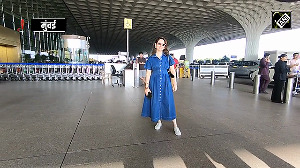Mongolia as a travel destination can take a lifetime to happen but rewards the intrepid traveller with enduring memories of a surreal, delightful land.

The trouble with returning from a destination like Mongolia, is that once you're back home, unpacked and ready to glide into the known, it all starts to seems surreal.
You're compelled to wonder whether you really did criss-cross the length and breadth of one of the coldest deserts in the world?
Whether you really did stay in yurts and gers and sipped camel milk vodka?
Whether the tune playing on a loop in your head is really the haunting melody of the Mongolian fiddles?
And whether you were really arched to such abounding skies and pinned on never-ending earth.
But I'm getting ahead of myself.

Why Mongolia? It is hardly on people's bucket lists. It isn't fashionable. Or trending in any way.
Though it occupies such a massive land mass, it sits, almost like an enigma, as untouched and raw as a land and its people can be in today's day and age.
And that's exactly why!
Mongolia lies in East-Central Asia, sandwiched between China and Russia, with the Gobi Desert blanketing much of its southeastern part.
Known for its vast rugged landscapes and nomadic culture, the one name that everyone instantly associates with Mongolia is that of Chinggis Khan. In fact, from the moment we land into Ulaanbaatar, the country's capital, everything from its international airport to its vodka, from its currency to its high streets bears testimony to its founder and its most famous flag bearer, Chinggis Khan.
I land into Ulaanbaatar after a long haul from Kolkata via Delhi and Hong Kong, and get into the hotel only by dinner time. The adventures must follow only after a good night's rest. As I draw the curtains, I notice the hotel overlooks the town square that proudly sports an equestrian statue of the Mongolian revolutionary hero, Sukhbaatar.

The next day, we drive overland for about five or six hours towards Kharakhorum, sighting herds of freely grazing cattle, sheep, goats and even horses.
Our guide, Ching, a wonderfully affable and knowledgeable man in his mid-30s, tells us that the animals of any Mongolian family are extremely important to them and that the ratio of animal to man in the country leans towards the animals, at least four-fold.

By afternoon, we reach the legendary Erdene Zu monastery, the very first Buddhist monastery established way back in the 1500s by Altan Khan.
In the last few hundred years of its existence, the monastery has battled several upheavals, from absolute neglect and closure to a partial revival in the form of a museum and monastery.
When our guide explains that the periphery of the monastery is dotted with 108 stupas, a sacred number in Buddhism, he is pleasantly surprised to learn that, that it is the same in Hinduism. The vast compound houses three temples dedicated to the three stages of Buddha's life: childhood, adolescence and adulthood.
Our next stop is the Kharakhorum Museum, which also houses a wonderful calligraphy art gallery. We're told that the age-old Mongolian script needs a very practiced hand and that not too many young Mongolians know or can properly write the ancient letters, though efforts are being made to keep it alive.
Interestingly, we're encouraged to wield a brush, dip it into black ink and try our hand at writing a few words in Mongolian, while literally being hand-held by an expert.
The well-curated collection at the museum's souvenir shop makes us dig into our wallets to pull out our first tugriks generously.

The next morning, we wake up to lashing winds and rain as though we carried the Indian monsoon with us. The packed raincoats come handy and we soon head out after a quick breakfast. The vast, overcast skies look spellbinding. We are still on tarmac roads that are now gradually getting narrower.
We drive for about four to five hours through bright yellow canola (rapeseed) fields, and bolts of lightning, to reach our first camp called the Gobi Nomadic Camp. And get our first sighting of rows of white gers, that seem almost like igloos at first glance. These circular portable dwelling units have been makeshift homes for centuries for all of Central Asia and Mongolia.
Made of sheep felt, that keeps the dwelling warm, the gers withstand harsh terrain and weather and are lugged camel-back and pitched as necessary, as the nomadic Mongolians move from place to place, setting up home.

We're invited inside one of the gers and greeted by a typical Mongolian nomadic family. Forming a circle, we sit on stools and are served a welcome drink and a welcome snacks comprising dried curd, yak milk, yak cheese and a kind of fried dough, by the children of the family.

Everyone is dressed in traditional Mongolian silk, donning headgear called buriads.
We are told that a ger can be set up and dismantled in all of three hours; that it always opens into the south and that the sun's rays falling into the ger, helps the household tell time, quite accurately! Though gers are a compact dwelling unit, there are certain rules that are adhered to.
The right wall belongs to the men, where they hang their tools, or whip or jackets; the left wall belongs to the women and the north wall is dedicated to the altar.
I spot a picture of a very young-looking Dalai Lama placed sacredly on the north wall on a mantle. He is the most celebrated Indian association for most Mongolians.

All along, our conversation is moderated by Ching, as neither group understands a word of what the other is saying.
Fortunately, music needs little translation, and soon we're treated to some unforgettable Mongolian music. Two men fish out wooden instruments which we are told are called horse-headed and goat headed-fiddles. One is strummed, whilst the other one is played using a bow.
A third man, holding a string of tightly-strung bones, joins them. He hits the string against his knee, keeping rhythm while also lending his voice.

The daughter of the family, the pure vocalist in the group, completes the quartet. They play and whistle and sing with great abandon, their fiddles in perfect sync and our group is left quite enthralled.
We also hear throat singing, a classical Mongolian technique of using the human voice to create deep, base dronish notes, until it starts to create somewhat of a hypnotic feel. I am delighted that the group has the songs on a CD and I pick up a copy as soon as their live performance is over.
The musical bit over, we step out of the gers to meet the animals and to witness their deep understanding and bonding with nature. Sheep wool, laid out in the sun, is being beaten with long sticks by a group as they sing along.
Vodka is being made using camel milk. Proud Bactrian, double-humped camels, yaks and steed horses stand tall and parade. The bond between man and beast is palpable.
We're explained how every bit and part of an animal is put to some use -- from its hide and hair to its bones in making musical instruments, its milk which is consumed and sold. It is a cold country where temperatures go down to -30 °C and meat is a must.
Mongolians consume beef, camel and even horse meat, though our guide was sensitive enough to the handful of vegetarians in our all-girl group and kept us fortified with salads and soup all along.
We thank the families for all their warm hospitality with a bunch of gifts we've got for them from India.
Handing over small parcels of stationery, gifts and clothes -- that bring evident delight to the faces of the mothers and children -- is indeed a heart-warming moment for all of us.

Mongolia is too vast to be covered only by road and the next morning, we take a domestic flight from Ulanbaatar to Dalanzadgad, or DZ, which turns out to be a tiny airport sans conveyor belt. Our luggage is brought to a little room, no bigger than a garage, tucked away at the rear end of the airport. Instead of one big bus, we now have four large muscular SUVs waiting for us.
We've reached South Gobi and the terrain is drier and rockier. We're told this region has been receiving rains and hence the entire land is sprouting wild onion pods!
There's practically nothing for as far as the eye can see except earth and maybe the odd herd of grazing sheep and goats.
It is an absolute mystery as to how the drivers don't lose their way as we're literally in the middle of nowhere, with no network, tracks or roads. Just an ever-stretching mass of land and the sky above us. It is surreal.

We're headed to a key attraction of the country, locally called Bayanzag and more popularly known as Flaming Cliffs.
The Flaming Cliffs was a name given by American explorer Roy Chapman Andrews, who was leading an expedition here in 1922 to discover the origin of man (the first human remains as per the Out of Asia theory) but instead chanced upon the first dinosaur eggs (belonging to a species of rhinocerotoids) the world had ever seen!
Roy felt that the terrain emitted a flame-like shade and hue, particularly during sunrise and sunset and coined the name Flaming Cliffs, which stuck.
The site continues to be a significant one for palaeontology. The landscape is truly stunning, leaving us all quite trigger happy. The colour of earth is a golden brown, somewhat akin to Jaisalmer. It is every bit worth the long, desolate drive.
After spending a couple of hours, we make it back to our jeeps that take us to our gers. The evening sky turns out to be an overcast one with a wild breeze that I can hear lashing into the ger covers.
If anyone is still in denial of global warming and climate change, they need to listen to what we faced the next day as we headed out of Bayanzag to drive towards Khongor Sand Dunes, aka Singing Dunes. Leaving our camps behind, we headed out into the open against a thick cloud cover. The terrain was more or less the same, just a tad rockier. But our 4x4 vehicles ensured our ride was as smooth as could be.
We were scheduled to reach the Khongor Sand Dunes in about five hours. Our cavalcade of five jeeps (one more added for better accommodation of luggage) was ripping through the terrain, when suddenly the first navigating jeep ahead of us, made a sudden stop, halting us all in our tracks.
Nobody got out and nobody moved. We were left wondering what the issue could be? A flat tyre? A predator? We had been told Mongolia had wolves. Since we were out of network, we could not even call the guide. And our driver spoke zero English.
After waiting for about five minutes that seemed much longer, our guide stepped out of the jeep and said in a hushed tone, one that we had not heard him use before, that a "big river" was coming.
A big river? In the middle of the Gobi? We were at our wits' end but were asked not to move out of the vehicle. After about ten odd minutes, we saw a trickle of water barely a few feet away from us, gushing in our direction with great speed. It was inexplicable.
And within a few minutes, that tiny trickle, had turned larger and more forceful, eating up almost more than two or three feet of the earth, just a few yards away from us. We had been hit by flash floods in the middle of the Gobi desert and would have been badly caught in it, had it not been for the vigilant eyes of our guide who sensed a river coming!
We had to wait for an hour-and-a-half for the current to subside, after which all of us got out and let out our emotions. Cameras came out with a vengeance and videos and pictures were clicked. Raw noodles, chocolates and theplas were gobbled up and passed around as we were well past lunch hours and fairly ravenous.
Ching explained that our only option was to wait till the "river" receded and then move forward cautiously, as there was no other way and turning back was not an option as we had already covered more than half of the distance.
Finally, we did start moving ahead unhurt, though somewhat shaken and stirred and made it, to the Singing Dunes or the Khongor Sand Dunes, 600 km away from Ulaanbaatar.

As if to reward us for our resilience and adventurous journey, we were in for a village fair. The entire village had gathered near the sand dunes, partaking in joyous activities such as archery, wrestling, balloon shots, award-winning horse parades and various other shenanigans.
Whilst some of us sat around sipping Altan Gobi beer, watching Mongolians indulge in their national sport of wrestling and playing their version of the game Simon Says, the other half decided the sand dunes were calling out to them and ascended them all the way to the summit.
Our final days in Mongolia were spent in Ulaanbaatar. In the last 10 odd days, we had been cut off from civilisation as it were, arched to abounding skies and enveloped by an ever-expansive earth. The city girl in all of us kicked in when the bus stopped at a cashmere shop, the one thing that is an absolute must-buy when in Mongolia.
Because of the bitterly cold winters, unique to the country, the goats there grow the world's highest-quality cashmere. A little over an hour spent in the three-storeyed building and we all came out with bags full of jackets and vests and shawls.

Before bidding adieu to Mongolia, we had to visit the monument dedicated to its most fabled national hero, Chhingis Khan.
We drove towards the suburbs of Ulaanbaatar, about an hour or so away from the city to Tov province, to be greeted by a massive statue of Chhingis Khan on horseback; very imposing and life-like. Made of 250 tonnes of steel, and standing tall at 130 feet, the statue shows the mighty warrior wielding a golden whip in his right hand.

The whip is all steel too. One can take an elevator all the way up to reach the horse's head where panoramic vistas await. The complex also has an interesting museum, a cafe and a souvenir shop beside a giant Mongol boot on display, going all the way from the ground to the top floors, alongside the escalators.
It is hard to imagine that the Mongolia we know today, vast, unending and peaceful, abounding in enigmas, and shrouded in mystery with tales of shamans and eagle hunters, was the very land that was recognised and feared the world over for the devastation it caused and for the many countries it invaded and conquered.
The Mongol empire, established by its national hero, not only revitalised the Silk Road but also brought warring tribes together, thus cementing Mongolia's place on the global map.

Mongolia as a travel destination has taken months to plan and a lifetime to happen. Twelve odd days spent there shall continue to stand out in my memory and experience for they are incomparable to most of my travels, domestic or overseas.
As I close my travel diary, that is crammed with notes from all that was experienced, seen, done and shared, I find that the two wild onion flowers plucked from the Gobi desert, now gentle and softer hued, bear testimony to my travels to this mystical land.
Supriya Newar is a writer and poet from Kolkata. Besides being a music aficionado, she is also an avid traveller, particularly drawn to places that have a je ne sais quoi about them. She may be reached on connect@supriyanewar.com.
Her Web site is: www.supriyanewar.com (external link).
Her travel in Mongolia was organised by Women on Wanderlust. Several tour companies arrange tours in Mongolia. Wanderlust Mongolia offers several types of packages for visiting the country; the 10 days/9 nights-package for exploring the Gobi Desert will set you back by Rs 1.52 lakhs and does not include airfare to Ulaanbaatar.
Feature Presentation: Ashish Narsale/Rediff.com











 © 2025
© 2025